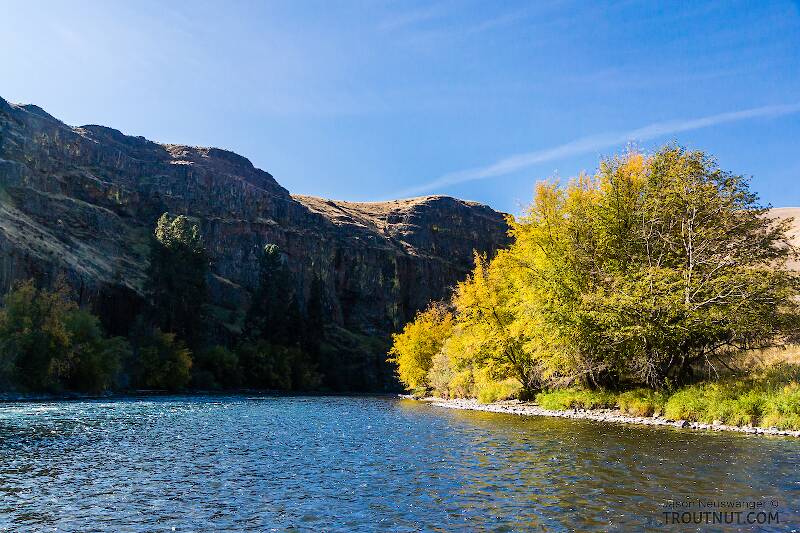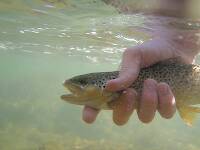
Blue-winged Olives
Baetis
Tiny Baetis mayflies are perhaps the most commonly encountered and imitated by anglers on all American trout streams due to their great abundance, widespread distribution, and trout-friendly emergence habits.
Featured on the forum

This dun emerged from a mature nymph on my desk. Unfortunately its wings didn't perfectly dry out.

Troutnut is a project started in 2003 by salmonid ecologist Jason "Troutnut" Neuswanger to help anglers and
fly tyers unabashedly embrace the entomological side of the sport. Learn more about Troutnut or
support the project for an enhanced experience here.
Trowpa on Dec 29, 2006December 29th, 2006, 10:07 pm EST
I love the underwater photos - gives me a better idea of what I'm trying to represent to the fish, but I have a question:
Maybe this has been done already and I've just been oblivious in my googling...but has anyone taken or seen any underwater photos of what our patterns actually look like when underwater? I'd love to see some side by side comparisons of different nymph patterns with the real thing - a fly can look great dry sitting in a vise, but once it gets wet, and floats along the cushion its a whole different story. Jason, or anyone else - do you know of any of these pictures? If not - can I make a request to add some to the site? :)
Maybe this has been done already and I've just been oblivious in my googling...but has anyone taken or seen any underwater photos of what our patterns actually look like when underwater? I'd love to see some side by side comparisons of different nymph patterns with the real thing - a fly can look great dry sitting in a vise, but once it gets wet, and floats along the cushion its a whole different story. Jason, or anyone else - do you know of any of these pictures? If not - can I make a request to add some to the site? :)
-Steve
Martinlf on Dec 30, 2006December 30th, 2006, 3:37 am EST
Now that's an interesting proposition. And I believe I know someone who just might try this. Let's see if he rises to your fly, Trowpa.
In the meantime, see Rick Hafele's new book on nymphing. He does place some flies alongside naturals in collection dishes, and not always with encouraging results to my eye. But, as I argue elsewhere, fish may see this matter differently. I do like his discussion of different nymphing styles, his ideas for preserving specimens make sense, and the goofy DVD is worthy of some of our most playful threads here--and instructive to boot.
In the meantime, see Rick Hafele's new book on nymphing. He does place some flies alongside naturals in collection dishes, and not always with encouraging results to my eye. But, as I argue elsewhere, fish may see this matter differently. I do like his discussion of different nymphing styles, his ideas for preserving specimens make sense, and the goofy DVD is worthy of some of our most playful threads here--and instructive to boot.
"He spread them a yard and a half. 'And every one that got away is this big.'"
--Fred Chappell
--Fred Chappell
Troutnut on Dec 30, 2006December 30th, 2006, 11:31 am EST
How much entomology is in Hafele's new book?
Photographing flies underwater is an interesting idea I've toyed around with just a little bit but I don't have anything worthwhile to show for it. I don't really think photos of nymphs underwater would be terribly instructive, except to show the way their color changes when they're wet. With most of the materials we use, everything will stick out in the same way underwater as it does in the air. It will move differently, but a still photo can't capture that.
Something more instructive that I would like to get around to is photographing various styles of dry flies from underwater and comparing those photos to natural insects. There are some old photos like that in several books but it would be good to have high-quality color digital photos of modern patterns to discuss.
Photographing flies underwater is an interesting idea I've toyed around with just a little bit but I don't have anything worthwhile to show for it. I don't really think photos of nymphs underwater would be terribly instructive, except to show the way their color changes when they're wet. With most of the materials we use, everything will stick out in the same way underwater as it does in the air. It will move differently, but a still photo can't capture that.
Something more instructive that I would like to get around to is photographing various styles of dry flies from underwater and comparing those photos to natural insects. There are some old photos like that in several books but it would be good to have high-quality color digital photos of modern patterns to discuss.
Jason Neuswanger, Ph.D.
Troutnut and salmonid ecologist
Troutnut and salmonid ecologist
Martinlf on Dec 31, 2006December 31st, 2006, 2:44 am EST
Jason,
With a Masters in Aquatic Entomology, he has have to have some bug study in the book. Chaper 6 is devoted to mayflies, stoneflies, caddisflies, scuds, and sowbugs. It's mostly pretty basic, but he does make some interesting points on distribution, abundance, nymph availability, and emerger availability for some specific bug Families that are interesting. A buddy lent me his copy of the book, and I'm still digesting it. Hafele also describes different nymph fishing methods (Brooks, Czech, Sawyer, Skues) in ways that are helpful. Photos and illustrations are abundant, and well done. Looking back through it, I don't find the bug and fly side by side comparisons; they must be on the DVD.
I'd love to see more photos of dry flies from underwater, especially at different stages of emergence and in different water and light conditions. I know this will be difficult, though, and how in the world do you keep from pitching the camera in the back of the car and digging out the wand if fish begin rising? Well, I'm glad you seem to have the necessary restraint; the photos are a joy to behold.
With a Masters in Aquatic Entomology, he has have to have some bug study in the book. Chaper 6 is devoted to mayflies, stoneflies, caddisflies, scuds, and sowbugs. It's mostly pretty basic, but he does make some interesting points on distribution, abundance, nymph availability, and emerger availability for some specific bug Families that are interesting. A buddy lent me his copy of the book, and I'm still digesting it. Hafele also describes different nymph fishing methods (Brooks, Czech, Sawyer, Skues) in ways that are helpful. Photos and illustrations are abundant, and well done. Looking back through it, I don't find the bug and fly side by side comparisons; they must be on the DVD.
I'd love to see more photos of dry flies from underwater, especially at different stages of emergence and in different water and light conditions. I know this will be difficult, though, and how in the world do you keep from pitching the camera in the back of the car and digging out the wand if fish begin rising? Well, I'm glad you seem to have the necessary restraint; the photos are a joy to behold.
"He spread them a yard and a half. 'And every one that got away is this big.'"
--Fred Chappell
--Fred Chappell
Troutnut on Dec 31, 2006December 31st, 2006, 2:48 am EST
how in the world do you keep from pitching the camera in the back of the car and digging out the wand if fish begin rising?
The underwater photos are usually taken during periods of boredom when the fish aren't rising. The Pentax Optio WPi is a pocket-sized thing I keep with me whenever I'm fishing, so it's easy to pull it out when I feel like taking photos.
Jason Neuswanger, Ph.D.
Troutnut and salmonid ecologist
Troutnut and salmonid ecologist
Trowpa on Dec 31, 2006December 31st, 2006, 4:58 am EST
Jason - are you pleased with the wpi? I'm looking for a camera that is easier to handle on the stream without being stressed about getting it wet (my current camera is not water resistant and I keep it in a plastic baggy - and fumble clumsily trying to get the camera out of the bag and take a picture of fish I catch. I routinely drop the fish before the picture is taken, and I am certain that i'm going to drop the camera some day as well! So...do you recommend the wpi?
-Steve
Troutnut on Dec 31, 2006December 31st, 2006, 2:28 pm EST
I would recommend the WPi, although there is a more recent model in the same line now. I forget the specific name, but you should probably go for the most recent one.
My only problem with the WPi is that it's really bad in low light compared to most digital cameras I've used, which can be a problem during some of the prettiest hours to be on the stream. Still, it's fine for most on-stream stuff including fish pics, and it's really really nice not to have to worry about getting it wet or even dropping it to the bottom of the stream.
My only problem with the WPi is that it's really bad in low light compared to most digital cameras I've used, which can be a problem during some of the prettiest hours to be on the stream. Still, it's fine for most on-stream stuff including fish pics, and it's really really nice not to have to worry about getting it wet or even dropping it to the bottom of the stream.
Jason Neuswanger, Ph.D.
Troutnut and salmonid ecologist
Troutnut and salmonid ecologist
Obtuseangle
Posts: 6
Posts: 6
Obtuseangle on May 2, 2007May 2nd, 2007, 2:42 am EDT
Steve,
I read somewhere about a guy who tied his own flies and wanted to get the trout's eye view. He would put his flies in a small fish tank to do this. Sometimes he would put the real thing, if available, in the tank for comparisons.
Jason, some of the underwater shots are incredible. There is one that was taken up a crystal clear stream that is now my desktop. Nice.
I read somewhere about a guy who tied his own flies and wanted to get the trout's eye view. He would put his flies in a small fish tank to do this. Sometimes he would put the real thing, if available, in the tank for comparisons.
Jason, some of the underwater shots are incredible. There is one that was taken up a crystal clear stream that is now my desktop. Nice.
Quick Reply
Related Discussions
Topic
Replies
Last Reply
2
May 19, 2007
by Troutnut
by Troutnut
1
Aug 5, 2019
by Martinlf
by Martinlf
5
Jun 14, 2008
by Wiflyfisher
by Wiflyfisher




